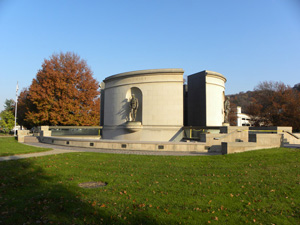

Remember...
Carl Wesley Pearl
1930-1950
"As a Korean War veteran, I know firsthand and understand the sacrifices made by our men and women in uniform."
Charles B. Rangel
 |
Remember...Carl Wesley Pearl
|
Carl Wesley Pearl was born on February 3, 1930, near Fairmont, West Virginia, to William Russell and Rose Santel Pearl. The family lived in Meredith Springs, with an address at the Rivesville Post Office. According to Carl Pearl's birth certificate, his father was a coal miner and his mother a housewife. The 1930 Federal Census, taken a couple of months after his birth, shows that Carl Pearl joined a family with two other sons, Russell Jr. and James. Mr. and Mrs. Pearl had been married since he was 19 and she, 14. By the time of the 1940 census, Mr. Pearl was a dispatcher in the coal mine and the family lived in Dakota of the Paw Paw District in Marion County.
According to a death notice published in the Fairmont Times ("Pfc. Carl Pearl Killed in Korea," September 19, 1950), Carl Pearl was "a prominent student at Rivesville High School," from which he graduated in 1947. He was known for playing baseball and basketball. The Times article states that he joined the service on October 28, 1949, received basic training at Fort Knox, Kentucky, and was sent to Camp Stoneman in California. From there, he was sent to Japan in April 1950. By this time, Carl's brothers, James and Russell Jr., were World War II veterans living at home.
Carl Pearl was assigned to the HQ Company, 2nd Battalion of the 35th Infantry Regiment, 25th Infantry Division of the U.S. Army, which was destined for South Korea.
On June 25, 1950, the North Korean People's Army crossed the border into the Republic of Korea. On June 28, Seoul, the capital of the Republic of Korea, was captured. On July 1, the U.S. ground combat troops arrived in Korea and entered the fray by July 5. During the period of July 10 through July 18, the 25th began moving from Japan to Korea. (U.S. Army Center of Military History, "The Korean War," accessed 1 July 2018, https://history.army.mil/reference/Korea/kw-chrono.htm.) While no record was found that verified that Carl Pearl was with them, he can be assumed to have moved with his unit.
The North Koreans, during the early months of the war, had great success against South Korean and United Nations forces by attacking them aggressively from the front and then flanking them on both sides. This strategy was a by-product of its superior numbers of men and equipment. The result was that the South Korean and United Nations troops were forced to retreat in chaos, with losses of equipment and men, and losses of any previous gains. The beginning of the end of these successes came in August as the United Nations forces, under the United States Eighth Army, established a line across the peninsula of Korea that could not be flanked. This line was known as the Pusan Perimeter. Reinforced by the United Nations' navy, the only option left to the North Korean army was to attempt to breach the line. They attacked in five locations, with the expectation that the North Korean army would break through in at least one location.
According to the article "The Second Battle of Naktong Bulge Explained," (accessed 5 July 2018, http://everything.explained.today/Second_Battle_of_Naktong_Bulge/): "During the North Koreans' September 1 offensive, the US 25th Infantry Division's US 35th Infantry Regiment was heavily engaged in the Battle of Nam River north of Masan."
No record could be found that verifies exactly where Private First Class Carl Pearl was on September 4, 1950, but his headstone application indicates he was killed in action on that date in South Korea. There is no record that verifies that Carl Pearl was with his unit, but given the date, it's likely he died while serving with the 25th during or in the aftermath of the Battle of Nam River.
Ultimately, the North Korean army did break through the Pusan Perimeter in more than one location but could not hold the positions it gained. As August ended and the fighting continued in and around the regions of the Pusan Perimeter into September, the North Korean initial superiorities in manpower and equipment began to collapse as they gained ground and distance and as the United Nations developed a better logistical strategy and supply chain. Fighting continued to be aggressive and heavy but resulted in North Korea being driven from previous strongholds. The United Nations took Seoul later in September 1950, but the fighting was reduced to a stalemate during the years 1951 to 1953. Armistice was reached in 1953. (Additional historical information from "Battle of Pusan Perimeter Explained," accessed 5 July 2018, http://everything.explained.today/Battle_of_Pusan_Perimeter/ and "First Battle of Naktong Bulge Explained," accessed 5 July 2018, http://everything.explained.today/First_Battle_of_Naktong_Bulge/.)
His father, William Russell Pearl, died September 5, 1953, three years to the day plus one after his son died. Mrs. Pearl remarried to Francis Keefover in 1957.
Article prepared by Cynthia Mullens
July 2018

West Virginia Archives and History welcomes any additional information that can be provided about these veterans, including photographs, family names, letters and other relevant personal history.